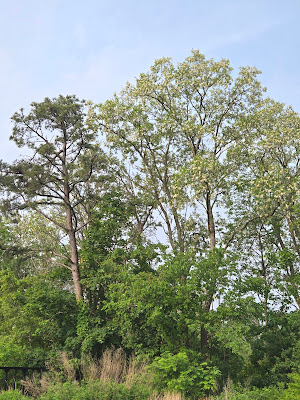Although bird life is in a quiet season at Halibut Pont, we walk expectantly most mornings with the belief that anything might happen, and why not to us?
 |
A bird crossing the quarry |
One day this week a flying silhouette carried promise of novelty and adventure.
 |
Greater Yellowlegs |
A long-legged bird landed far down the rim of the quarry. We could tell it was a Greater Yellowlegs, a wader of marshes and estuaries that is a rarity here. There was a sporting chance of sneaking up behind a cedar tree and photographing it through the branches. I got one nice close-up before it took off in a tirade of squeaky alarm calls, chew-chew-chew.
 |
Great Blue Herons |
From up in the sky came a guttural squawking as a pair of Great Blue Herons considered landing at the quarry, their long legs trailing at the ready.
 |
Green Heron |
Next came the croak of a Green Heron flying in to the water's edge with a raspy skeow call, triply repeated. In past years it has been the most regular of the long-legged set, nesting in quarry-side trees. It's absence this season has been a loss to the Park ambience, though a relief to the minnow population.
 |
Balletic preening |
During its brief visit the Green Heron reprised graceful photogenic poses but didn't settle in for a traditional fishing vigil.
 |
Yellowlegs through the foliage |
We pursued the Greater Yellowlegs to a shrouded spot on the other side of the quarry. The foliage that shielded our stealthy approach obscured the view until the last moment but added a pleasing vignette to the portrait. It was a serendipitous touch on a morning of chances.


























































.jpg)
